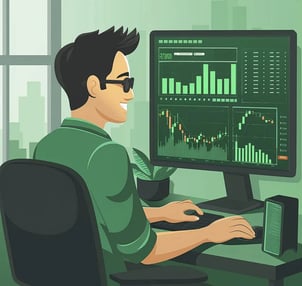3 min read
Scientist Discovered Why Most Traders Lose Money – 24 Surprising Statistics
“95% of all traders fail” is the most commonly used trading related statistic around the internet. But no research paper exists that proves this...
Margin trading and leverage are powerful tools in the arsenal of online traders. At its essence, margin trading allows traders to borrow funds to purchase more shares than their available capital would normally permit. This financial leverage can significantly magnify profits on successful trades. However, the flip side is that losses can also be amplified, making margin trading a strategy that carries considerable risk alongside its potential rewards.
This article aims to provide a comprehensive overview, ensuring that traders are well-informed about the practices and precautions necessary for engaging in margin trading effectively. Whether you're new to online trading or seeking to expand your trading knowledge, understanding the dynamics of margin trading is essential for informed decision-making in the volatile world of online investing.
Margin trading is a financial strategy that allows traders to access greater sums of capital by borrowing funds from a broker, enabling the purchase of more securities (stocks, Forex lots, Futures contracts, Crypto coins) than would be possible with their available funds alone. This approach leverages existing capital as collateral for the loan, aiming to enhance potential returns on investments. However, it's crucial to grasp the mechanics and implications of using leverage in trading to navigate this terrain “safely”.
 At its core, margin trading begins with the opening of a margin broker account, distinct from a standard trading account. Traders must deposit a minimum amount of capital, known as the "initial margin". This deposit serves as a good faith requirement, ensuring traders have skin in the game.
At its core, margin trading begins with the opening of a margin broker account, distinct from a standard trading account. Traders must deposit a minimum amount of capital, known as the "initial margin". This deposit serves as a good faith requirement, ensuring traders have skin in the game.
Once the account is funded, traders can borrow up to a certain percentage of the purchase price of the securities. This borrowing capacity is typically expressed as a ratio, such as 2:1 (leverage) or 50% margin, allowing traders to double their purchasing power. For example, with $10,000 in a margin account and a 50% margin requirement (2:1 leverage), a trader could potentially buy up to $20,000 worth of stock.
 Scenario: Imagine a trader, Alex, who has a strong belief that the stock of Company XYZ, currently priced at $100 per share, is going to rise in the next few weeks. Alex has $5,000 available for trading and decides to use margin trading to leverage the investment.
Scenario: Imagine a trader, Alex, who has a strong belief that the stock of Company XYZ, currently priced at $100 per share, is going to rise in the next few weeks. Alex has $5,000 available for trading and decides to use margin trading to leverage the investment.
Margin Details: Alex's brokerage allows a 2:1 leverage ratio, meaning Alex can borrow up to the amount of their investment ($5,000) to buy additional stock, effectively doubling the purchasing power to $10,000.
Trade Execution: Alex uses the entire $10,000 to buy 100 shares of Company XYZ at $100 each. A few weeks later, as predicted, the stock price increased to $120 per share.
Outcome: Alex decides to sell all 100 shares at $120, resulting in $12,000. Alex's net profit from the trade, excluding commissions and other possible fees, is $6,900 ($12,000 - $5,000 = $7,000), compared to a $2,000 profit without using margin ($1,000 profit from the increase in stock price times the 50 shares they could have bought with just their own $5,000).
 Scenario: Jordan decides to trade the EUR/USD Forex pair, believing the Euro will strengthen against the US Dollar. Jordan has $2,000 to invest and decides to use margin to increase the potential return.
Scenario: Jordan decides to trade the EUR/USD Forex pair, believing the Euro will strengthen against the US Dollar. Jordan has $2,000 to invest and decides to use margin to increase the potential return.
Margin Details: The Forex broker offers a 50:1 leverage ratio, a common leverage level in Forex trading. This allows Jordan to control a position worth $100,000 with the $2,000 investment (50 times the invested amount).
Trade Execution: Jordan uses the leverage to buy €82,000 worth of EUR/USD at an exchange rate of 1.2200, expecting the Euro to appreciate.
Market Movement: Contrary to Jordan's expectations, the Euro weakens against the Dollar, and the EUR/USD exchange rate drops to 1.2000.
Outcome: With the exchange rate moving against the position by 0.0200 (from 1.2200 to 1.2000), the total loss on the €82,000 position is $1,640 (€82,000 * 0.0200). Because Jordan is controlling a $100,000 position with just $2,000, this movement represents an 82% loss on the initial investment, leaving Jordan with only $360 of the original $2,000 after closing the position ($2,000 - $1,640 = $360).
| Trade Outcome | Amount Risked | Leverage Ratio | Total Investment Value | Price Change (%) | Final Value of Investment | Profit/Loss |
|---|---|---|---|---|---|---|
| Winner | $5,000 | 2:1 | $10,000 | +10% | $11,000 | +$1,000 |
| Break-Even | $5,000 | 2:1 | $10,000 | 0% | $10,000 | $0 |
| Loss | $5,000 | 2:1 | $10,000 | -10% | $9,000 | -$1,000 |
| Large Loss | $5,000 | 2:1 | $10,000 | -20% | $8,000 | -$2,000 |
This table demonstrates the potential outcomes of margin trading with a 2:1 leverage ratio, highlighting the impact of different market movements on the trader's final position. It clearly shows how leverage magnifies both profits and losses, emphasizing the importance of strategic planning and risk management in margin trading. Integrating this table into the article can provide readers with a clearer understanding of the tangible effects of leverage on trading outcomes, enhancing their grasp of the concepts discussed in the text.
Leverage is the main advantage of margin trading, increasing both potential gains and losses. A successful trade on margin can significantly increase the return on investment compared to trading with one's funds exclusively. However, leverage can just as easily worsen losses if the market moves against the trader's position. This heightened risk underscores the importance of careful strategy and risk management in margin trading.
Brokers set minimum margin requirements to protect their loans, requiring traders to maintain a certain level of equity in their margin accounts. If a trade's value falls below this "maintenance margin," the trader will receive a margin call, demanding additional funds to bring the account back into good standing. Failure to meet a margin call can lead to the broker liquidating positions within the account to cover the shortfall, often at inopportune times.
Margin trading, while inherently risky, presents unique opportunities that can be highly attractive to informed and strategic traders. The primary allure of margin trading lies in its potential to significantly enhance investment returns. By borrowing capital to invest in the market, traders can achieve a higher level of exposure to favorable movements in asset prices, thereby amplifying their profits on successful trades.

The ability to purchase more securities than one's capital alone would allow can lead to significantly higher returns. For instance, if a trader uses margin to double their investment in a stock that then appreciates in value, their percentage return on the actual invested capital can be substantially greater than if they had not leveraged their investment. This amplification effect is the most compelling advantage of margin trading, offering the chance to accelerate portfolio growth under the right market conditions.
Margin trading also enables traders to diversify their portfolios more extensively than would be possible with their available capital. By spreading investments across a wider range of assets, traders can potentially reduce unsystematic risk, improving the overall risk-reward profile of their portfolio. Diversification, a cornerstone of sound investment strategy, becomes more attainable with the increased purchasing power margin trading provides.
For traders with a clear strategy and a deep understanding of the market, margin trading offers access to additional capital that can be used to leverage investment opportunities quickly and efficiently. This can be particularly valuable in fast-moving markets, where the ability to act swiftly can make a significant difference in investment outcomes.
While the opportunities in margin trading are compelling, it's imperative to acknowledge and understand the risks involved. Margin trading amplifies not only potential returns but also potential losses, making it essential for traders to approach with caution and a comprehensive risk management strategy.

The most pronounced risk in margin trading is the potential for amplified losses. Just as leverage can increase profits, it can also magnify losses. If the market moves against a leveraged position, traders face losses that exceed their initial investment, potentially requiring them to deposit additional funds to cover the shortfall. This can deplete capital rapidly in volatile markets, underscoring the need for careful position sizing and risk management.
A direct consequence of amplified losses is the dreaded margin call. If the equity in a margin account falls below the maintenance margin requirement, brokers will issue a margin call, demanding the deposit of additional funds or securities to cover the deficit. Failure to meet a margin call can lead to the broker liquidating positions within the account at possibly unfavorable prices, further exacerbating losses. This scenario highlights the importance of monitoring positions closely and maintaining adequate liquidity to address margin calls promptly.
The psychological aspect of trading with leverage cannot be overstated. The potential for higher profits can tempt traders to take on excessive risk or to hold onto losing positions in hopes of a market reversal. Similarly, the stress of facing potential margin calls and the fear of forced liquidation can lead to poor decision-making. Developing a disciplined trading plan and adhering to it rigorously is vital to managing the psychological pressures associated with margin trading.
Margin trading in volatile markets increases the risk of rapid and significant losses. Price swings can quickly move against a position, triggering margin calls or leading to the closure of positions at a loss. Traders must be especially vigilant in volatile markets, employing strategies such as stop-loss orders to protect against unforeseen market movements.
To navigate the high-risk, high-reward environment of margin trading successfully, traders must employ effective strategies. These strategies not only aim to maximize the potential benefits but also mitigate the inherent risks. A disciplined approach, combined with a thorough understanding of the market and one's own risk tolerance, forms the foundation of successful margin trading.
Set Stop-Loss Orders: One of the most critical strategies in margin trading is the use of stop-loss orders. These orders automatically sell a security when it reaches a specific price, limiting potential losses. By setting stop-loss orders, traders can prevent a bad trade from spiraling out of control, especially in volatile markets.
Position Sizing: It's crucial to determine the size of each trade carefully. Investing a small portion of your portfolio in any single trade can help manage risk, ensuring that a loss on one position doesn't significantly impact your overall trading capital. Diversifying trades and not over-leveraging on a single position are key components of effective position sizing.
Maintain Discipline: Perhaps the most challenging aspect of margin trading is maintaining discipline. It's essential to stick to your trading plan and resist the temptation to overtrade or chase losses. Emotional decision-making can lead to significant mistakes in a leveraged trading environment.
Continuous Learning: The market is always evolving, and so should your trading strategies. Successful margin traders are always learning — from the market, from their trades, and the trading community. Staying informed and adaptable is crucial.
 Engaging in margin trading demands a disciplined approach and adherence to best practices to protect your trading capital and mental capital against the heightened risks it presents. By following a set of established guidelines, traders can navigate the volatile waters of leveraged trading more safely and effectively.
Engaging in margin trading demands a disciplined approach and adherence to best practices to protect your trading capital and mental capital against the heightened risks it presents. By following a set of established guidelines, traders can navigate the volatile waters of leveraged trading more safely and effectively.
Knowledge is the first line of defense in margin trading. Before diving into leveraged positions, ensure you have a solid understanding of how margin works, including the calculation of leverage, the implications of margin calls, and the specific requirements of your brokerage. Comprehensive education on the mechanics of the securities you're trading and the strategies you're employing is crucial.
For those new to margin trading, starting small is advisable. Begin with modest leverage to get a feel for the amplified risks and potential rewards without exposing yourself to undue risk. This approach allows you to learn from your experiences without jeopardizing significant capital.
Implementing stop-loss orders can dramatically reduce the risk of large losses. By automatically closing out positions at a predetermined price, you protect yourself against market downturns, especially during volatile trading periods.
Margin trading requires vigilant monitoring of your positions. Market conditions can change rapidly, and being proactive in your response can mean the difference between a manageable loss and a devastating margin call. Regularly review your investments and be prepared to take action as needed.
Ensure your margin account has sufficient capital to meet margin requirements and withstand market fluctuations. Keeping a buffer can help you avoid margin calls and provide flexibility to maneuver when opportunities or challenges arise.
A well-considered risk management plan is indispensable. Determine in advance how much of your portfolio you're willing to risk on margin trades, and stick to this limit. This plan should include strategies for diversification, position sizing, and exit plans for both profitable and unprofitable positions.
Finally, successful margin trading involves keeping emotions in check. Decisions should be based on rational analysis and adherence to your trading plan, rather than fear or greed. Staying emotionally detached helps maintain discipline and focus on long-term goals.
In conclusion, margin trading and leverage offer a pathway to potentially amplify returns on investment, presenting both significant opportunities and inherent risks. Understanding the mechanics of margin trading, from leveraging trades to navigating the complexities of margin calls, is fundamental for anyone looking to explore this aspect of online trading. By employing effective strategies and adhering to best practices, traders can mitigate the risks associated with margin trading. This includes setting stop-loss orders, closely monitoring investments, diversifying portfolios, and maintaining discipline in the face of market volatility. Equally important is the continuous pursuit of knowledge and the development of a sound risk management plan. While margin trading can indeed elevate the potential for higher profits, it requires a well-considered approach and a steadfast commitment to prudent trading practices. For those who navigate its challenges wisely, margin trading can be a valuable tool in achieving their investment objectives.

3 min read
“95% of all traders fail” is the most commonly used trading related statistic around the internet. But no research paper exists that proves this...

3 min read
Trendlines can be great trading tools if used correctly and in this post, I am going to share three powerful trendline strategies with you.

3 min read
Choosing the right trading journal is essential for traders wanting to analyze performance, refine strategies, and improve consistency. In this...
